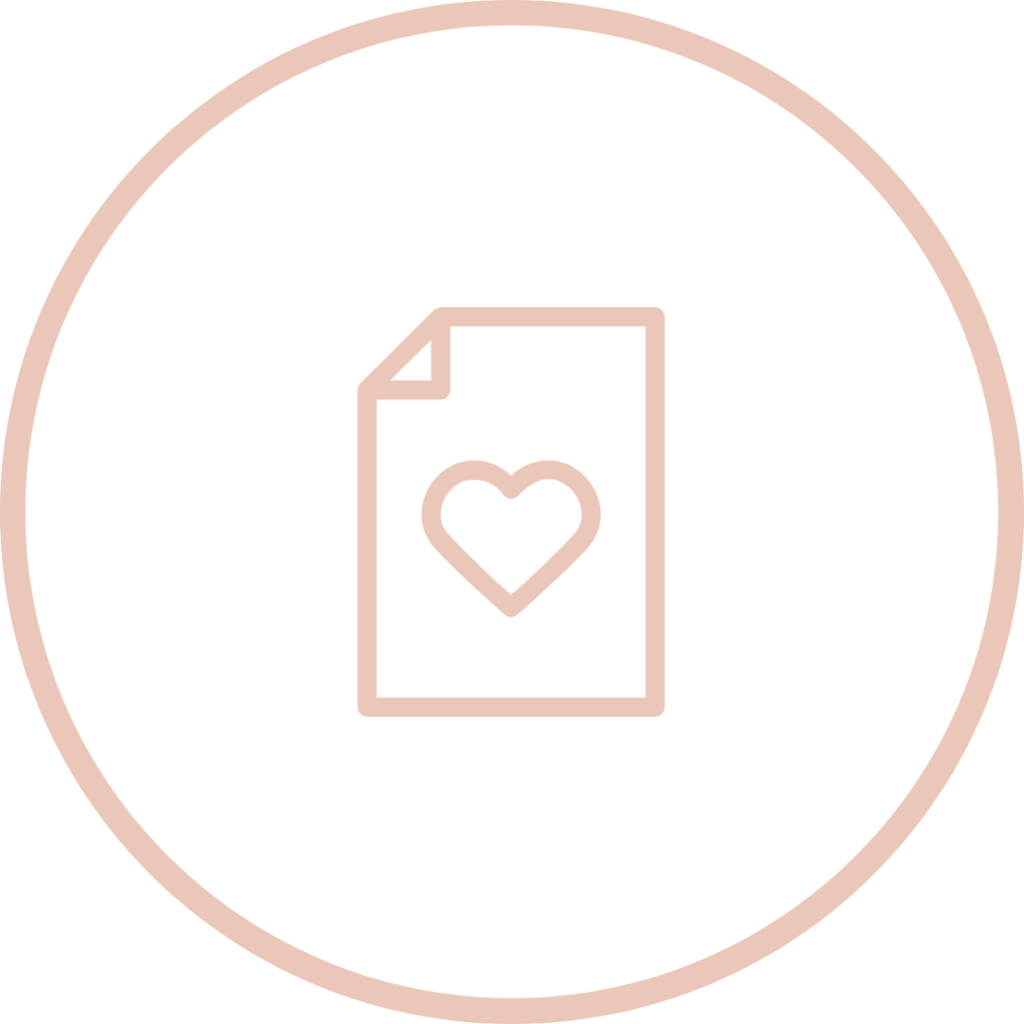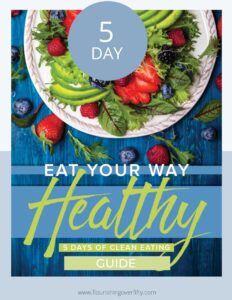What is Healthy Eating and Why is it Important?

Healthy eating is a fairly simple concept. I define Healthy Eating as developing a lifestyle focused on eating foods that support your overall best health – eating real, whole foods the majority of the time and choosing organic and sustainable options whenever possible. It is not about a specific diet, a set meal plan or list of specific foods that are allowed or not allowed.
Healthy eating is a choice and a lifestyle, not a diet. While there are guidelines, you don’t have to follow strict rules every day and the goal is improved health and (for me) increased energy as opposed to losing weight. I view it as a healthy way of living, not a diet.
Healthy eating is all about building an understanding of what foods support your overall health and energy and what foods take away from you looking and feeling your best. And while I don’t believe in a specific list of what to eat or not eat, there are guidelines that can provide a framework for what is generally considered by nutritionists as supportive of good health. It includes a focus on cooking and eating at home more often and avoiding highly processed, refined foods.
As Michael Pollan says, “Eat Food. Not Too Much. Mostly Plants.”
Healthy eating is important because it is not about depriving yourself of things you enjoy – it’s about finding healthy ways to enjoy food and nutrition. It’s about feeling great, having more energy, improving your health, and boosting your mood.
It’s important to note that I try not to use the word diet or talk about losing weight when I discuss healthy eating. I’m not focusing on calorie counts or cutting out specific nutrients. I encourage you to make that mindshift as well. Forget the word diet and embrace healthy living. When you do, it goes a long way towards shifting your focus from what you can’t eat (and feeling deprived) to what you can eat and how you are supporting your beautiful body.

Note: My favorite blender to use is the NutriBullet for a budget friendly choice. If you would like to use a higher quality, more professional blender, you can invest in the Vitamix but be sure of your commitment as this is an expensive tool.
Components of Healthy Eating
Overall, healthy eating means a focus on non-processed, fresh, real whole foods as opposed to processed and refined foods. Another way to look at it is to focus on foods that come in their natural state (like fruits and vegetables) and those with few ingredients and little packaging. It’s all about making better, nutritious choices on a regular basis.
This means embracing vegetables, whole foods, unrefined grains, lean proteins, and healthy fats and avoiding processed foods whenever possible.
Your initial goal should be to decide why you want to eat healthier (hint: overall improved health and more energy is a good place to start). From there you can determine what foods work best for you and it will help make decisions when you find yourself facing a dessert table or making a decision at a restaurant.
Your mindset is important – it is a lot easier to say to yourself that you are making your food choice because it supports your goals and health vs saying to yourself that you are not allowed to have something.
Your Health and Nutrition
For women our age, I encourage you to discuss your nutrition plans with your doctor as they may provide specific guidance if needed to address a health concern. There are some conditions such as metabolic syndrome, prediabetes and diabetes, and Nonalcoholic Fatty Liver Disease (NAFLD)
that will be best addressed with specific goals when it comes to your food intake. Another big part of eating clean is to keep your blood sugar levels in check. This means avoiding the refined sugar foods and eating more fiber-rich nutrient-dense options. It also means eating regularly and not skipping meals. The better you stay on top of your blood sugar levels, the better you will feel.
You’ll want to assess your thoughts about eating dairy, animal protein and how alcohol fits into your overall plan. You’ll also want to determine your beverage preferences. I don’t need to tell you that plain water is the best beverage and soda isn’t a good choice but you need to decide what works best for you.
There are many popular nutrition plans [Weight Watchers, Keto, Low Carb, Mediterranean, Interval] so you might want to review those as well to see if there are ideas that work for you. Or do what I did – review them all and select the best ideas that will work for you to create a custom nutrition plan.

Healthy Eating Plan
Here are some overall guidelines to help you create your Health Eating Plan:
- Meal Planning: I have found that investing more time in meal planning makes a big difference in my ability to maintain healthier eating every day. At least once a week I plan meals and determine what I need from the grocery store. It’s when I don’t have healthy options on hand that I find myself reaching for that frozen dinner or boxed meal that’s in the pantry.
- Read Labels: Get used to reading labels. You will be shocked initially at how much sugar and junk is included in foods you often consume, even those you thought were healthy. A great example – a cauliflower crust pizza – sounds healthy, right? If you read the label you’ll find that many of these have a significant amount of sugar, carbs and calories.
- Select Real Food: Focus each meal around fresh, real food including vegetables, fruits, lean protein, unrefined carbs, with some good fat included. To help with this, here’s another Michael Pollan quote: Don’t eat anything your great-grandmother wouldn’t recognize as food.
- Be Picky about Snacks: Find healthier snacks to replace bad choices. Nuts and seeds are a great option, chopped veggies with dip, hummus – there are quite a few options once you start looking.
- Grains: If you are including grains, look for 100 percent whole grain. Read the label – many items say “contains whole grain” but the amount is minimal. The label must say “100% Whole Grain”
- Beverages Count: Your main beverage choice should be water (get this great water bottle to help track) but including tea, coffee and unsweetened beverages is ok. Be sure to look at what you are adding to your drinks as well. For me, coffee is tricky as I love to add a whole lot of cream and that doesn’t sit well in my stomach so I have black tea instead most days. Fake sweeteners are not our friends either – but you knew that already, right?
- For lean protein, consider fish as well as locally, pasture raised meat when possible. This can be a challenge as the price difference can be significant – I try to eat smaller portions to compensate.
- Plants: Eat more plant-based foods. Veggies should be your best friends so find ones that you like and/or ways to prepare them that can become your staple go-tos. Right now, our family is loving brussel sprouts and I love cauliflower. Roasting is my favorite way to prepare them as they caramelize. Other ideas include eating more plant-based proteins, such as beans, lentils and peas, and high-protein whole grains, like quinoa, barley and buckwheat.
- Health Fats: Include healthy fats such as avocados, coconut oil, avocado oil, olive oil. Start learning how to cook with different oils. For example, you don’t want to use extra virgin olive oil to cook with high heat. Here is a short article by Dr. Mark Hyman that discusses fats.
- Start Cooking: Start cooking at home more often. This goes a long way towards supporting a healthier meal plan.
Healthy Eating – What to Reduce or Avoid
While I like to keep the focus on all the great things you can enjoy while eating healthy, there are some items to avoid or significantly reduce. I think that if you listened to your body after indulging in most of these items, it would tell you that these aren’t good for you based on how you feel (tired, bloated, etc.).
- Processed Foods: Reduce or eliminate processed foods – pretty much anything that comes in a box or a bag, has a long list of ingredients (aim for 1-5 ingredients total) and ingredients that you cannot pronounce or spell. (Why would you want to put that stuff in your body anyway?)
- Refined grains: Refined means it’s been processed – this includes most pasta, bread, white flour, white rice. Yes, I hear your groan…I’m not saying you can never have pasta or a piece of bread again but I want to make sure that when you have those items you are keeping an eye on the serving size and surrounding that meal with healthy items too.
- Refined or artificial sweeteners: This includes sugar, any form of corn syrup, cane juice, or artificial sweeteners. Try honey and pure maple syrup but these still need to be in moderation as all sugars should be limited.
- Fried Foods and Fast Food – I think you know this already!
- Alcohol consumption. I think everyone has to decide for themselves what they want their relationship with alcohol to be. My recommendation is that you think about what your goal is. Some people will stop all alcohol while others will include a glass or two a week of wine or beer. I think alcohol in moderation is a good goal, but for some, too much alcohol leads to making bad food choices or they lack the ability to stop at just 1-2 drinks so that may not be a good goal for them.
- Soda and juice – If you are not a soda or juice drinker this one is easy, but if you are, I know this is a hard one. Think about your goals and set some limits if you need to, and find an alternative (sparkling seltzers are a great idea). Are they worth it to you?
For help with meal planning go my Healthy Eating Meal Plans post and for help with grocery shopping go to my Ultimate Grocery List post.
I hope this has provided some good food for thought about how you can transition to healthy eating or reinforced those good decisions you’ve been making. To dive more into this healthy eating journey, here are a few of my favorite resources:
- My favorite blender to use is the NutriBullet for a budget friendly choice. If you would like to use a higher quality, more professional blender, you can invest in the Vitamix but be sure of your commitment as this is an expensive tool.
- https://drhyman.com/ has a great podcast and several good healthy eating books. I like his concept of Pegan eating which is a focus on vegan but supports some meat as well.
- Michael Pollan’s In Defense of Food
- Forks Over Knives Cookbook ….and Documentary on Amazon Prime
- Whole30 – Program Overview and great Cookbooks
- My favorite healthy eating cookbooks:
Leave a comment below – I would love to hear from you what your healthy eating journey looks like and your favorite cookbooks or resources.







Great article! This covers all the basic to start eating healthy. I love that it is all about creating your specific goals and not abiding by a diet someone else created.
Outstanding article. It really is a choice and as we all know choices can be hard especially with all the treats this time of year. I try to eat what I call sheet pan chicken and vegetables. It’s great heated up the next day. I do want to start meal planning for the week.
Love this! I’m only in my 20s but I have been having health problems and decided to turn to nutrition to help with them and it’s amazing how much a good diet can do for you.
Great! This post complements mine. There are so many health problems that can be avoided just by following healthy eating habits. Thanks!
Great tips. Eating at home and meal prepping always help me eat healthy!
Wonderful post. I totally agree with all the point you mentioned. Also cutting down everything is not an option you can eat whatever you like but in certain limit. You should enjoy healthy eating.
I hit the reset button daily when it comes to making healthy eating choices. I tend to start my day off with a smoothie around 10am. Thanks for these simple reminders.